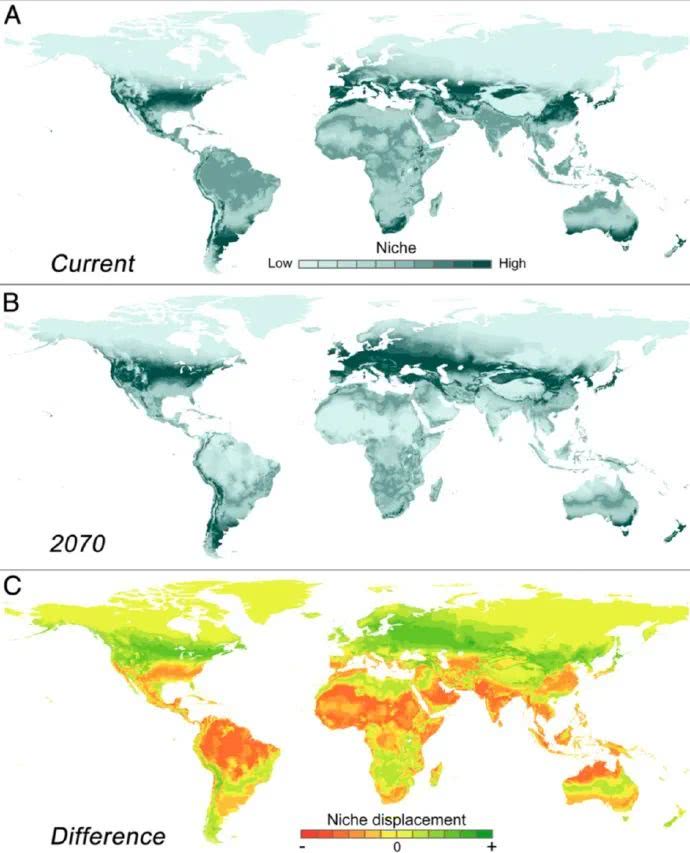(单词翻译:单击)
听力文本
Study: One-Third of Humans Could Face Almost "Unlivable" Heat by 2070
A new study predicts that in just 50 years, as many as 3.5 billion people could be facing "near-unlivable" heat.
The extreme heat would be a result of rising world temperatures linked to human-made climate change, the study suggests.
Researchers from the United States, China and Europe were involved in the study. The Proceedings of the National Academy of Sciences reported the results.
Marten Scheffer is an ecologist at Wageningen University in the Netherlands. He helped lead the research.
He said the research shows that historically, human populations have mostly lived in areas where the average yearly temperature was between 11 to 15 degrees Celsius. A smaller number lived where the average temperature was higher, between 20 to 25 degrees.
Scheffer said that since these population centers have existed for several thousand years, it suggests the areas represent a climate "niche" necessary for human survival.
But if world temperatures keep rising, this could put large parts of the population in areas too warm to live in without cooling technology, Scheffer and his team reported.
The exact number of people who could be put at risk depends on whether pollutant levels of heat-trapping carbon dioxide can be reduced and how fast the world population will grow.
Under the worst-case predictions for population growth and carbon pollution, the study estimates about 3.5 billion people could be living in extremely hot areas by 2070. That would be one-third of the world's projected population.
Even predictions considered by some scientists to be more likely estimate at least two billion people will be living in places too hot to survive without air conditioning in 2070, the study found.
"It's a huge amount and it's a short time. This is why we're worried," Cornell University climate scientist Natalie Mahowald told The Associated Press. She was not part of the study. But she and other outside scientists said the research makes sense and presents the urgency of man-made climate change differently than past studies.

The new study used an unusual method to identify the climate niches the research is based on. A team of international scientists studied humans like they do bears, birds and bees to find the areas where human populations live and thrive. The researchers looked back 6,000 years to create the niche areas.
Currently, about 20 million people live in places with an average yearly temperature greater than 29 degrees Celsius. The areas make up less than 1 percent of Earth's land, and mostly near the Sahara Desert. But as the world gets warmer and more crowded, the study predicts that large areas of Africa, Asia, South America and Australia will also likely be in the same temperature range.
Study co-writer Chi Xu of China's Nanjing University predicts that well over 1 billion people will be affected, possibly billions more. But he and other researchers noted there is still time for humans to make climate changing action to slow Earth's warming.
Marten Scheffer said in a statement the study's predictions would mean "unlivable" conditions "for the ordinary, for poor people, for the average world citizen." He said such conditions could lead to major climate migrations from the hottest areas of the world.
Tim Lenton is a climate scientist and director of the Global Systems Institute at Britain's University of Exeter. He helped lead the research. Lenton said countries like Nigeria — with a population expected to grow 300 percent by the end of the century — would likely face major difficulties if the predicted warmer conditions develop.
I'm Bryan Lynn.
重点解析
重点讲解:
1. depend on 取决(于);有赖(于);
The risk and severity of sunburn depend on the body's natural skin colour.
晒伤的风险和严重程度取决于人体的自然肤色。
2. be based on 以……为基础;
The selection process is based on rigorous tests of competence and experience.
选拔过程是基于对能力和经验的严格测试。
3. make up 组成;构成;
Women officers make up 13 per cent of the police force.
女警占警力的13%。
4. lead to 招致;致使;导致;
This suggestion will certainly lead to an argument.
这个建议必将引起一场争论。
参考译文
研究称到2070年全球可能有三分之一人口面临几乎"不宜居住的"高温
一项新研究预测称,在短短50年内,就可能有多达350万人面临“几乎不宜居住的”高温。
研究表明,极端高温可能是人为气候变化导致全球气温升高的结果。
来自美国、中国和欧洲的研究人员参与了这项研究。研究结果发表在《美国国家科学院院刊》上。
马丁·谢弗是荷兰瓦格宁根大学的生态学家。他帮助领导了这项研究。
他说研究表明,从历史上看,人类大多生活在年均气温在11到15摄氏度之间的地区。较少数人生活在平均气温更高的地区,介于20到25摄氏度之间。
谢弗表示,由于这些人口中心已经存在了数千年,因此这表明这些地区代表着人类生存所必需的气候“生态位”。
但谢弗及其团队报告称,如果全球气温持续升高,可能会使大部分人口生活在没有制冷技术就热得无法生活的地区。
可能面临风险的具体人数取决于导致温室效应的二氧化碳污染物水平是否能降低,以及世界人口的增长速度。
根据对人口增长以及碳污染的最坏情况预测,研究估计到2070年可能有约350万人生活在极端炎热地区。这一数字是世界预期人口的三分之一。
研究发现,甚至一些科学家都预测称,到2070年可能至少有200万将生活在没有空调就热到无法生活的地区。
康奈尔大学的气候科学家纳塔莉·马霍尔德对美联社表示,“这牵涉庞大人口,而且缓冲时间很短。这就是我们担心的原因。”她并未参与这项研究。但她和其他外部科学家表示,这项研究言之有理,而且提出了不同于以往研究的人为气候变化的紧迫性。
这项新研究采用了一种不同寻常的方法来确定研究所基于的气候生态位。一个国际科学家团队像研究熊、鸟类和蜜蜂一样研究了人类,以寻找人类生存和繁衍的地区。研究人员回顾了6000年以创造生态位地区。
目前有约2000万人生活在年均气温高于29摄氏度的地区。这些地区在地球土地面积的占比不到1%,而且大部分都在撒哈拉沙漠附近。但随着全球变暖和变拥挤,研究预测非洲、亚洲、南美和澳大利亚的大部分地区很可能也将处于相同的气候范围之内。
来自中国南京大学的研究合著者徐驰预测,将有超过10亿人或数十亿人受到影响。但他和其他研究人员指出,人类还有时间采取气候变化行动来减缓地球变暖。
马丁·谢弗在一份声明中指出,这项研究的预测意味着环境“对普通人、穷人、普通的世界公民来说”不宜居住。他说,这种环境可能导致全球最热地区的大规模气候迁移。
蒂姆·伦顿是英国埃克塞特大学的气候科学家兼全球系统研究所所长。他协助领导了这项研究。伦顿表示,像尼日利亚这种到本世纪末人口预计将会增长300%的国家,如果预期变暖情况持续发展,那这些国家可能面临重大困难。
布莱恩·林恩报道。
译文为可可英语翻译,未经授权请勿转载!


